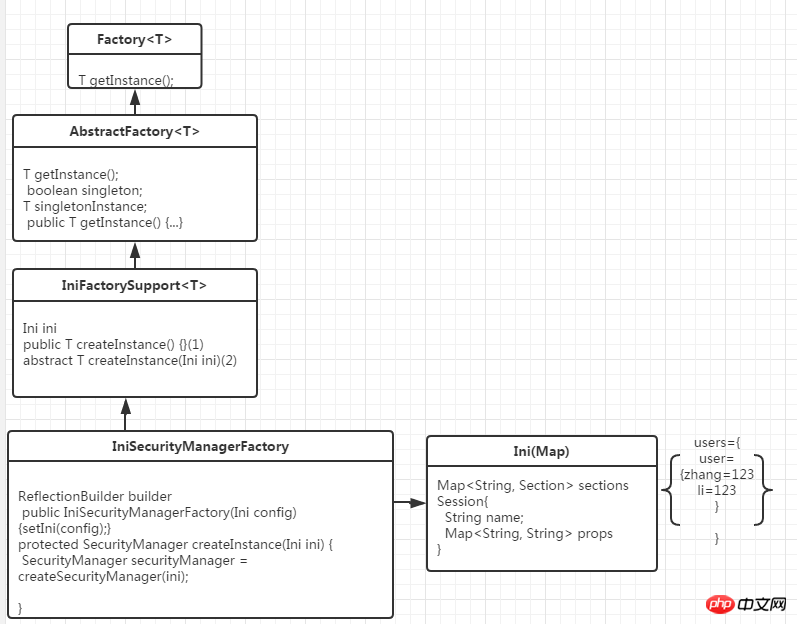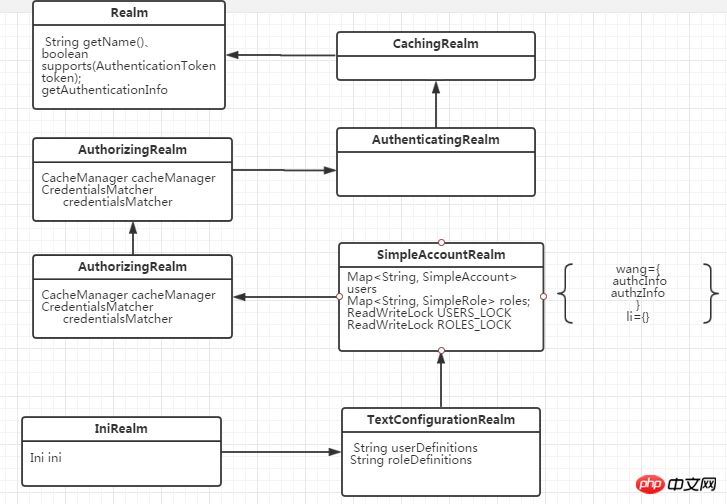
(3)abstractFactory类主要设置是否单例
(4)iniFactorySupport是支持ini设置创建的对象
(5)iniSecuritymanagerFactory是ini方式创建securityManager的实现类
(二)//2、得到SecurityManager实例 并绑定给SecurityUtils1 IniSecurityManagerFactory类:2 creatSecuritymanager(ini){3 SecurityManager securityManager = createSecurityManager(ini);4 return securityManager;5 }
1 private SecurityManager createSecurityManager(Ini ini) { 2 //null 3 Ini.Section mainSection = ini.getSection(MAIN_SECTION_NAME); 4 if (CollectionUtils.isEmpty(mainSection)) { 5 6 //try the default: null 7 mainSection = ini.getSection(Ini.DEFAULT_SECTION_NAME); 8 } 9 return createSecurityManager(ini, mainSection);10 }(3)通过ini对象和主模块mainSession创建Securitymanager
1 private SecurityManager createSecurityManager(Ini ini, Ini.Section mainSection) { 2 //{securityManager=DefaultSecurityManager,iniRealm=IniRealm} 3 Map defaults = createDefaults(ini, mainSection); 4 Map objects = buildInstances(mainSection, defaults); 5 6 SecurityManager securityManager = getSecurityManagerBean(); 7 boolean autoApplyRealms = isAutoApplyRealms(securityManager); 8 if (autoApplyRealms) { 9 //realms and realm factory might have been created - pull them out first so we can initialize the securityManager:10 Collection realms = getRealms(objects);11 //set them on the SecurityManager12 if (!CollectionUtils.isEmpty(realms)) {13 applyRealmsToSecurityManager(realms, securityManager);14 }15 }16 return securityManager;17 } 1 private Map buildInstances(Ini.Section section, Map defaults) { 2 this.builder = new ReflectionBuilder(defaults); 3 return this.builder.buildObjects(section); 4 } 5 //类ReflectionBuilder 6 //通过mainSection创建对象并关联 7 public Map buildObjects(Map kvPairs) { 8 ..... 9 LifecycleUtils.init(objects.values());10 } 1 //类IniRealm 2 private void processDefinitions(Ini ini) { 3 Ini.Section usersSection = ini.getSection(USERS_SECTION_NAME); 4 processUserDefinitions(usersSection); 5 } 6 //通过userSection解析user模块 7 protected void processUserDefinitions(Map userDefs) { 8 for (String username : userDefs.keySet()) { 9 ........10 account = new SimpleAccount(username, password, getName());11 add(account);12 ........13 }14 }15 protected void add(SimpleAccount account) {16 String username = getUsername(account);17 USERS_LOCK.writeLock().lock();18 try {19 this.users.put(username, account);20 }finally {21 USERS_LOCK.writeLock().unlock();22 }
simpleAccount的结构为:


(7)设置DefaultSecurityManager的realm属性:
1 applyRealmsToSecurityManager(realms, securityManager){2 ((RealmSecurityManager) securityManager).setRealms(realms);3 }4 //在类RealmSecurityManager中5 public void setRealms(Collection realms) {6 this.realms = realms;7 afterRealmsSet();8 }注意:afterRealmsSet();主要用来设置authenticator、authorizer的realm属性:
1 //获取主题对象 2 public static Subject getSubject() {3 Subject subject = ThreadContext.getSubject();//第一次null4 if (subject == null) {5 subject = (new Subject.Builder()).buildSubject();6 ThreadContext.bind(subject);7 }8 return subject;9 }
(1)代码分析:使用建造者模式创建对象:
1 public static class Builder{ 2 SubjectContext subjectContext; 3 SecurityManager securityManager; 4 public Builder(SecurityManager securityManager) { 5 if (securityManager == null) { 6 throw new NullPointerException("SecurityManager method argument cannot be null."); 7 } 8 this.securityManager = securityManager; 9 this.subjectContext = newSubjectContextInstance();//DefaultSubjectContext(初始化一个backMap集合)10 if (this.subjectContext == null) {11 throw new IllegalStateException("Subject instance returned from 'newSubjectContextInstance' " +12 "cannot be null.");13 }14 this.subjectContext.setSecurityManager(securityManager);15 }16 public Subject buildSubject() {17 return this.securityManager.createSubject(this.subjectContext);18 }19 }(2)使用主题上下文创建主题
1 public Subject createSubject(SubjectContext subjectContext) { 2 //create a copy so we don't modify the argument's backing map: 3 SubjectContext context = copy(subjectContext); 4 5 //ensure that the context has a SecurityManager instance, and if not, add one: 6 context = ensureSecurityManager(context);//DefaultSubjectContext.backMap.put(SecurityManage) 7 8 //Resolve an associated Session (usually based on a referenced session ID), and place it in the context before 9 //sending to the SubjectFactory. The SubjectFactory should not need to know how to acquire sessions as the10 //process is often environment specific - better to shield the SF from these details:11 context = resolveSession(context);12 13 //Similarly, the SubjectFactory should not require any concept of RememberMe - translate that here first14 //if possible before handing off to the SubjectFactory:15 context = resolvePrincipals(context);16 17 Subject subject = doCreateSubject(context);18 19 //save this subject for future reference if necessary:20 //(this is needed here in case rememberMe principals were resolved and they need to be stored in the21 //session, so we don't constantly rehydrate the rememberMe PrincipalCollection on every operation).22 //Added in 1.2:23 save(subject);24 25 return subject;26 }(3)通过主题创建subject对象
protected Subject doCreateSubject(SubjectContext context) {return getSubjectFactory().createSubject(context);
}
1 public Subject createSubject(SubjectContext context) { 2 SecurityManager securityManager = context.resolveSecurityManager(); 3 Session session = context.resolveSession(); 4 boolean sessionCreationEnabled = context.isSessionCreationEnabled(); 5 PrincipalCollection principals = context.resolvePrincipals(); 6 boolean authenticated = context.resolveAuthenticated(); 7 String host = context.resolveHost(); 8 9 return new DelegatingSubject(principals, authenticated, host, session, sessionCreationEnabled, securityManager);10 }以上是shiro源码的详细介绍的详细内容。更多信息请关注PHP中文网其他相关文章!
 在Java应用程序中缓解平台特定问题的策略是什么?May 01, 2025 am 12:20 AM
在Java应用程序中缓解平台特定问题的策略是什么?May 01, 2025 am 12:20 AMJava如何缓解平台特定的问题?Java通过JVM和标准库来实现平台无关性。1)使用字节码和JVM抽象操作系统差异;2)标准库提供跨平台API,如Paths类处理文件路径,Charset类处理字符编码;3)实际项目中使用配置文件和多平台测试来优化和调试。
 Java的平台独立性与微服务体系结构之间有什么关系?May 01, 2025 am 12:16 AM
Java的平台独立性与微服务体系结构之间有什么关系?May 01, 2025 am 12:16 AMjava'splatformentenceenhancesenhancesmicroservicesharchitecture byferingDeploymentFlexible,一致性,可伸缩性和便携性。1)DeploymentFlexibilityAllowsibilityAllowsOllowsOllowSorlowsOllowsOllowsOllowSeStorunonAnyPlatformwithajvM.2)penterencyCrossServAccAcrossServAcrossServiCessImplifififiesDeevelopmentandeDe
 GRAALVM与Java的平台独立目标有何关系?May 01, 2025 am 12:14 AM
GRAALVM与Java的平台独立目标有何关系?May 01, 2025 am 12:14 AMGraalVM通过三种方式增强了Java的平台独立性:1.跨语言互操作,允许Java与其他语言无缝互操作;2.独立的运行时环境,通过GraalVMNativeImage将Java程序编译成本地可执行文件;3.性能优化,Graal编译器生成高效的机器码,提升Java程序的性能和一致性。
 您如何测试Java应用程序的平台兼容性?May 01, 2025 am 12:09 AM
您如何测试Java应用程序的平台兼容性?May 01, 2025 am 12:09 AM效率testjavaapplicationsforplatformcompatibility oftheSesteps:1)setUpautomatedTestingTestingActingAcrossMultPlatFormSusingCitoolSlikeSlikeJenkinSorgithUbactions.2)contuctualtemualtemalualTesteTESTENRETESTINGINREALHARTWARETOLEALHARDOELHARDOLEATOCATCHISSUSESUSEUSENINCIENVIRENTMENTS.3)schictcross.3)schoscross.3)
 Java编译器(Javac)在实现平台独立性中的作用是什么?May 01, 2025 am 12:06 AM
Java编译器(Javac)在实现平台独立性中的作用是什么?May 01, 2025 am 12:06 AMJava编译器通过将源代码转换为平台无关的字节码,实现了Java的平台独立性,使得Java程序可以在任何安装了JVM的操作系统上运行。
 在平台独立性的平台独立性上使用字节码优于本机代码的优点是什么?Apr 30, 2025 am 12:24 AM
在平台独立性的平台独立性上使用字节码优于本机代码的优点是什么?Apr 30, 2025 am 12:24 AMByteCodeachievesPlatFormIndenceByByByByByByExecutedBoviratualMachine(VM),允许CodetorunonanyplatformwithTheApprepreprepvm.Forexample,Javabytecodecodecodecodecanrunonanydevicewithajvm
 Java真的100%独立于平台吗?为什么或为什么不呢?Apr 30, 2025 am 12:18 AM
Java真的100%独立于平台吗?为什么或为什么不呢?Apr 30, 2025 am 12:18 AMJava不能做到100%的平台独立性,但其平台独立性通过JVM和字节码实现,确保代码在不同平台上运行。具体实现包括:1.编译成字节码;2.JVM的解释执行;3.标准库的一致性。然而,JVM实现差异、操作系统和硬件差异以及第三方库的兼容性可能影响其平台独立性。
 Java的平台独立性如何支持代码可维护性?Apr 30, 2025 am 12:15 AM
Java的平台独立性如何支持代码可维护性?Apr 30, 2025 am 12:15 AMJava通过“一次编写,到处运行”实现平台独立性,提升代码可维护性:1.代码重用性高,减少重复开发;2.维护成本低,只需一处修改;3.团队协作效率高,方便知识共享。


热AI工具

Undresser.AI Undress
人工智能驱动的应用程序,用于创建逼真的裸体照片

AI Clothes Remover
用于从照片中去除衣服的在线人工智能工具。

Undress AI Tool
免费脱衣服图片

Clothoff.io
AI脱衣机

Video Face Swap
使用我们完全免费的人工智能换脸工具轻松在任何视频中换脸!

热门文章

热工具

WebStorm Mac版
好用的JavaScript开发工具

Dreamweaver Mac版
视觉化网页开发工具

ZendStudio 13.5.1 Mac
功能强大的PHP集成开发环境

PhpStorm Mac 版本
最新(2018.2.1 )专业的PHP集成开发工具

EditPlus 中文破解版
体积小,语法高亮,不支持代码提示功能





